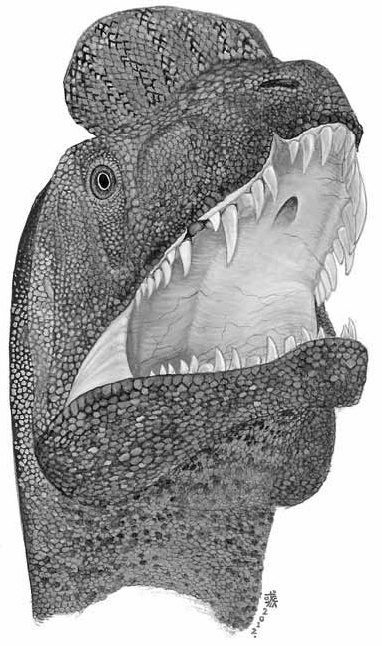Scientists conclude dinosaur had gum disease after biting
Updated: 2013-06-04 08:14
By Cheng Yingqi (China Daily)
|
||||||||
|
An impression of a Sinosaurus with dental disease. Provided to China Daily |
About 190 million years ago, a dinosaur got a toothache after biting into something hard. In fact, the damage was so bad, it damaged the gum.
Scientists found the fossilized jawbone of that Sinosaurus, which could be the earliest discovered animal that had a dental disease.
Scientists from China, the United States and Canada held a dental consultation on the dinosaur, taking X-rays and writing a report on its toothache, which was published in Chinese Science Bulletin last week.
"It was common for carnivorous dinosaurs to lose teeth, but this specimen we were studying was different," said Xing Lida, who co-authored the research report. "Its tooth socket was completely filled, which indicates the tooth loss was because of dental problems instead of external force."
In 2007, the Lufeng Dinosaurian Museum recovered an incomplete skull and several postcranial fragments of a new specimen of Sinosaurus from Lufeng Basin in Yunnan province.
Based on other Sinosaurus specimens, the complete upper jaw should have 13 or 14 tooth positions. The skeleton had two broken teeth preserved in the tooth socket.
An X-ray of the bone shows the outline of the original tooth socket. The space of the bad tooth is less radiolucent than the adjacent tooth socket - in other words, X-rays don't pass through as much - which indicates that secondary bone filled the space, the report said.
"When the dinosaur's teeth were lost or removed while it was alive, the bony socket remodeled over time, so that there was no longer a tooth socket," Xing said.
Scientists also found no pyrite rot in the socket of the bad tooth, while pyrite growth was observed over all the other tooth spaces.
"The osseous abnormalities after teeth loss is common among mammals, but it is rarely found on reptiles like the dinosaur," said professor Bruce M Rothschild, at the University of Kansas Natural History Museum and Biodiversity Research Institute, in a news release about the research report, which he also co-wrote.
Canadian paleontologist Phil R Bell compared the Sinosaurus jawbone to a skeleton of a ring-tailed lemur because the ring-tailed lemur likes chewing hard nuts, which causes teeth problems similar to those of the Sinosaurus.
"The dinosaur might have hurt its teeth and got the teeth problem for similar reasons," Bell said in the news release. "The study of disease and other abnormalities in the fossil record can reveal unique insights into the behavior, biology and development of extinct animals.
"For example, among theropod dinosaurs, injury-related trauma like bites, exostoses, fractures, infection and stress fractures are the overriding cause of osteopathy," he said.
chengyingqi@chinadaily.com.cn
(China Daily USA 06/04/2013 page6)

 Michelle lays roses at site along Berlin Wall
Michelle lays roses at site along Berlin Wall
 Historic space lecture in Tiangong-1 commences
Historic space lecture in Tiangong-1 commences
 'Sopranos' Star James Gandolfini dead at 51
'Sopranos' Star James Gandolfini dead at 51
 UN: Number of refugees hits 18-year high
UN: Number of refugees hits 18-year high
 Slide: Jet exercises from aircraft carrier
Slide: Jet exercises from aircraft carrier
 Talks establish fishery hotline
Talks establish fishery hotline
 Foreign buyers eye Chinese drones
Foreign buyers eye Chinese drones
 UN chief hails China's peacekeepers
UN chief hails China's peacekeepers
Most Viewed
Editor's Picks

|

|

|

|

|

|
Today's Top News
Shenzhou X astronaut gives lecture today
US told to reassess duties on Chinese paper
Chinese seek greater share of satellite market
Russia rejects Obama's nuke cut proposal
US immigration bill sees Senate breakthrough
Brazilian cities revoke fare hikes
Moody's warns on China's local govt debt
Air quality in major cities drops in May
US Weekly

|

|








